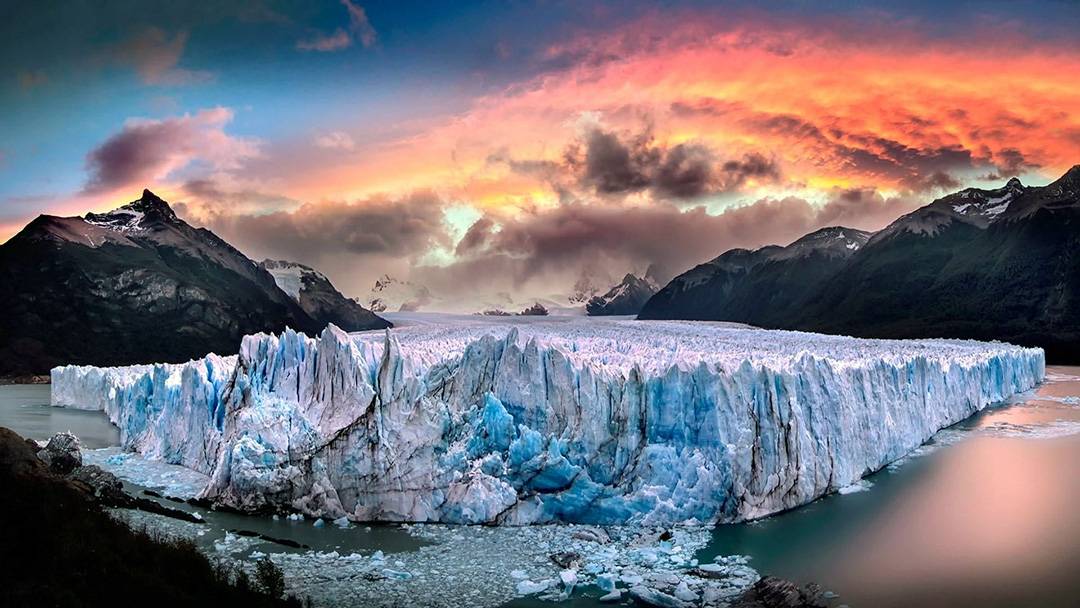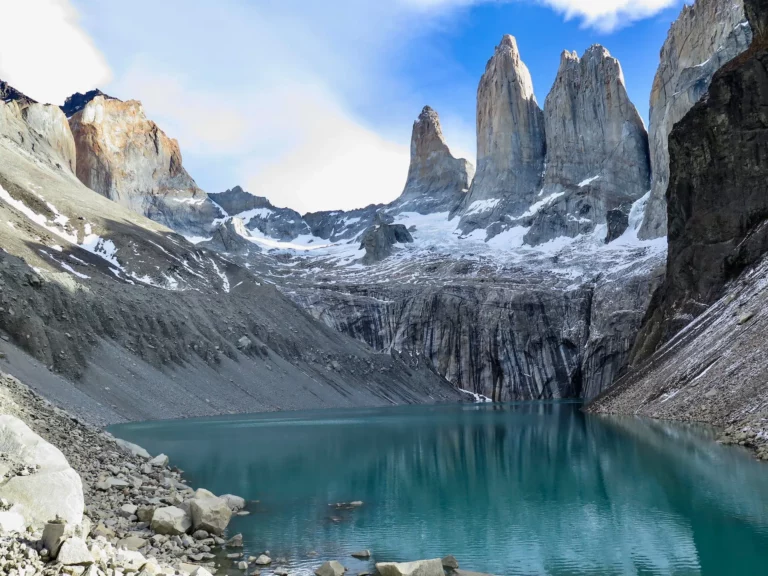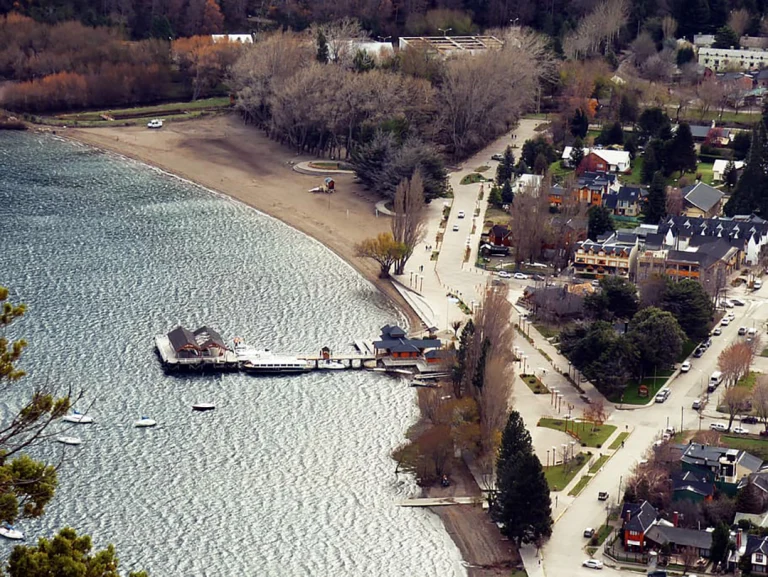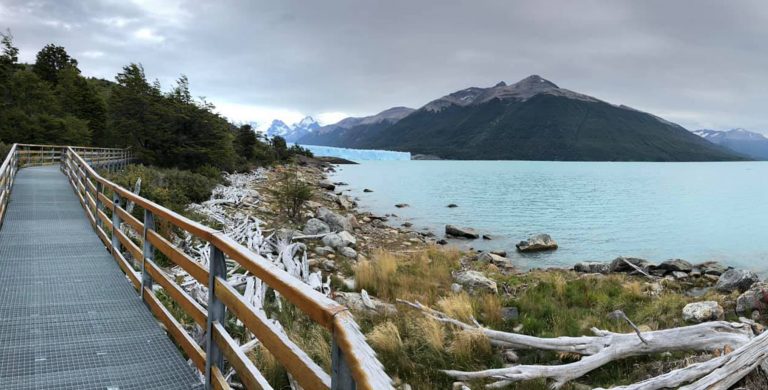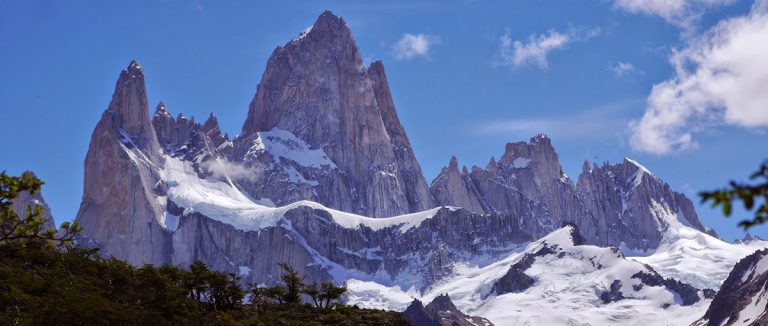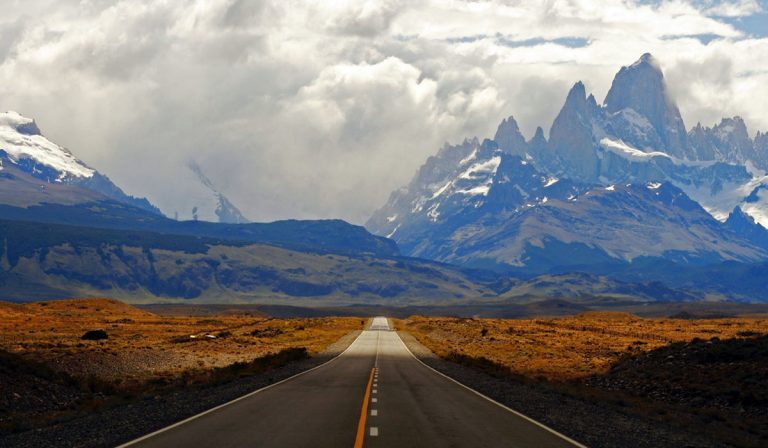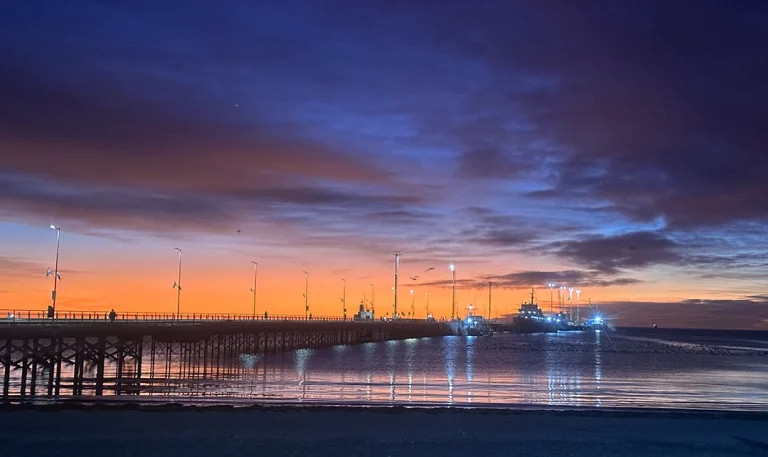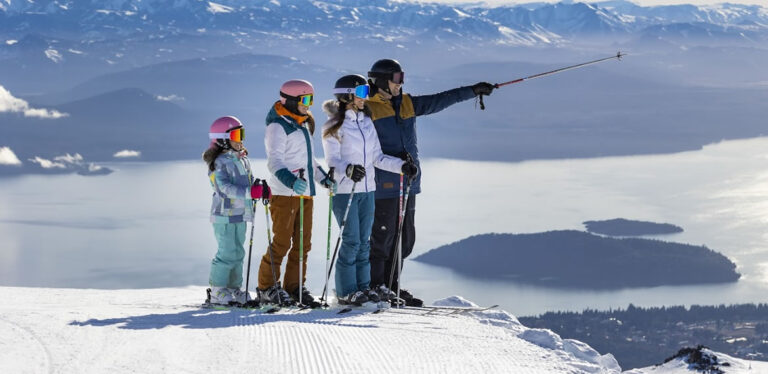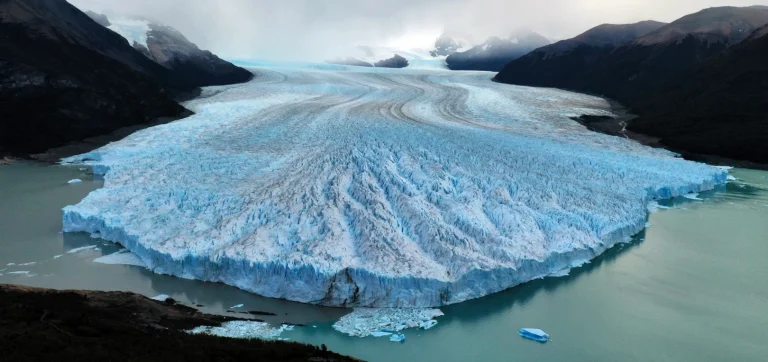The majestic Perito Moreno Glacier produces one of the most impressive natural spectacles in the world, when large pieces of ice fall due to the effect of the advance of the glacier on the waters of the lake. It is one of the most important tourist attractions in Patagonia.
For reasons that still continue to cause debate in the scientific community and despite the fact that most of the planet’s glaciers are retreating due to climate change and global warming, the Perito Moreno Glacier is one of the few glaciers that remains in a steady state because it continues to accumulate mass at a rate similar to its loss.

The water of the Argentine lake has a beautiful turquoise color product of the sediments brought by the advance of the glacier.
Perito Moreno Glacier Location
The glacier is located within the Los Glaciares National Park, in the province of Santa Cruz, in the Argentine Patagonia region, 78 km (48 miles) from the Perito Moreno Glacier is the town of El Calafate, also located 320 km northwest of the city of Río Gallegos, the capital of the province. Los Glaciares National Park covers an area of 724,000 ha and has 356 glaciers in total.
Unique show in the world
The glacier is an ice formation measuring 250 km2 (97 square miles), 30 km (19 miles) long, has a front of 5 km (3.1 miles) in length, and emerges above the lake level about 70 m (240 feet), plus the total depth of the ice is 170 meters (558 feet). It is one of the 48 glaciers that derive from the Southern Patagonian Ice Field, this ice field constitutes the third largest freshwater reserve in the world.
The constant advance of the glacier at a speed of almost 2 meters per day and 700 meters per year, forms a dam with the waters of the Rico lake´s arm, producing a slope of the lake of up to 30 meters. Due to the pressure of the water, the ice leaks and then a tunnel is formed with a height of up to 50 meters. Every several years, -specifically in average of the last century; every four and a half years – the collapse of this vault occurs, producing an imposing and unique spectacle in the world, attracting tourists from different countries, being one of the greatest attractions of the Park. In recent years since the establishment of the international airport, there has been an important economic development in El Calafate, the international tourism represents an important source of income for the growing development in the region.
.
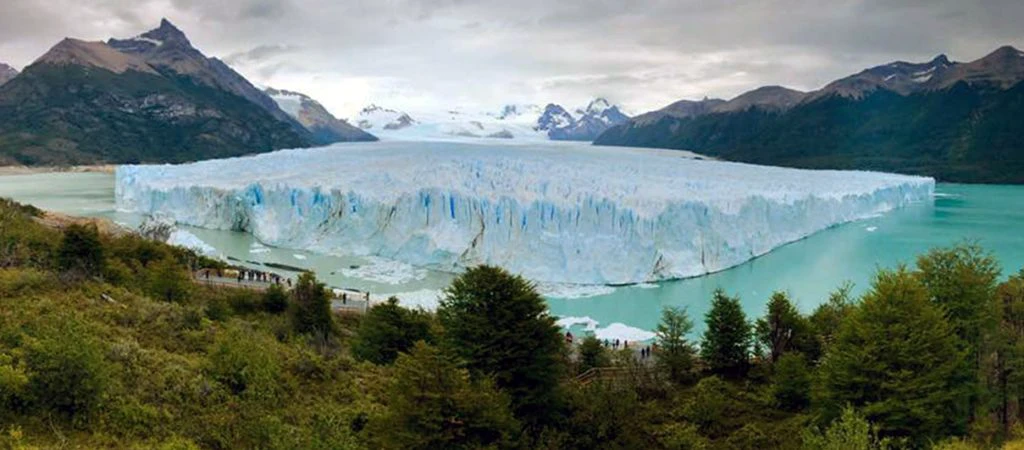
Ice Breaking Process
The glacier’s constant advance at a speed of almost 2 meters per day and 700 meters per year forms a dam with the waters of the Rico arm of the lake, causing a lake level difference of up to 30 meters. Due to the pressure of the water, filtrations occur in the ice, and then a tunnel up to 50 meters high is formed. Every few years—specifically every four and a half years on average over the past century—this vault collapses, creating an impressive and unique spectacle that attracts tourists from various countries, being one of the major attractions of the park.
This breaking process occurs at irregular intervals, the last time being in the early morning of March 12, 2018, when the park was closed, so there are no images or witnesses. The previous rupture occurred at 10:54 AM on March 10, 2016, and the one before that was on March 2, 2012. The list of recorded years when ruptures occurred includes: 2018, 2016, 2012, 2008, 2006, 2004, 1988, 1984, 1980, 1977, 1975, 1972, 1970, 1966, 1963, 1960, 1956, 1953, 1951 (strangely in winter), 1947, 1940, 1934, and 1917.
Excursion Sailing the South Face of the Glacier
Surprisingly, a small insect called Andiperla willinki inhabits the glacier ice. Also known as “the pearl of the Andes” or “the dragon of Patagonia,” this species of stonefly spends its entire life on the ice. It measures approximately 15 mm and feeds on bacteria that live in the ice, brought by the wind. This insect was discovered in 1956 on the Upsala Glacier by Aubert Willink. For many years it was believed to be extinct until it was rediscovered in 2001, 20 meters deep, in the Torres del Paine Glacier.
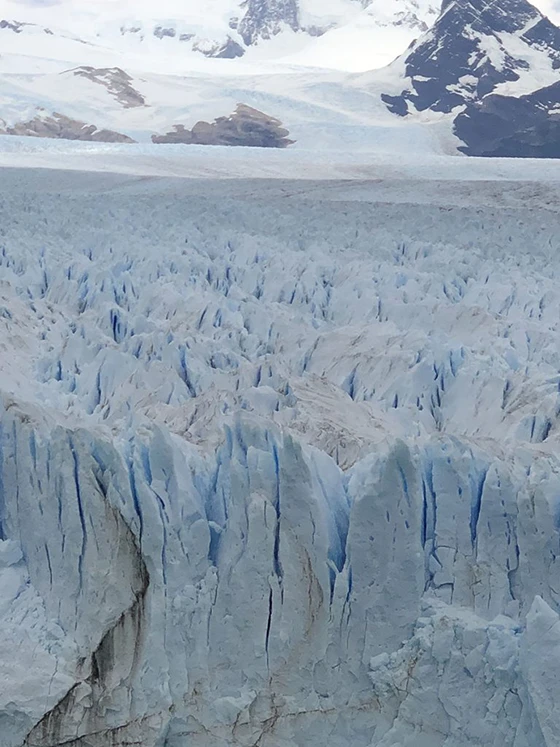
A Bit of History
Since its discovery and for many years, the glacier area was disputed between Argentina and Chile. In 1879, British captain of the Chilean Navy, Juan Tomás Rogers, was the first to sight the glacier. A few years later, Rudolph Hauthal, a representative of the Argentine Boundary Commission, also observed it.
Through the twists of history, when the boundary treaty between the two countries was signed, the glacier came under Argentine sovereignty. This was because certain rules were established, such as the boundary between the two countries in the Andes Mountains being up to the 52nd parallel, with lakes draining into the Atlantic falling under Argentine jurisdiction, and those draining into the Pacific falling under Chilean territory.
After several years of research, in 1899 the archaeological material collection, and surveying the area, the Argentine Lieutenant Iglesias, in charge of studies for the Argentine Hydrographic Institute, named it “Perito Moreno” in honor of Francisco Pascasio Moreno. Moreno, who was in charge of the Boundary Commission between Argentina and Chile, was known as “the expert” due to his extensive knowledge of the region. He was a pioneer who studied the region in the 19th century, and his studies played a crucial role in supporting the defense of Argentine territory in the border conflict with Chile.
View from the Los Glaciares National Park Facilities
Los Glaciares National Park has specially designed walkways to view the glacier from a distance of 400 meters. This circuit allows visitors to see the southern flank and the eastern edge of the glacier.
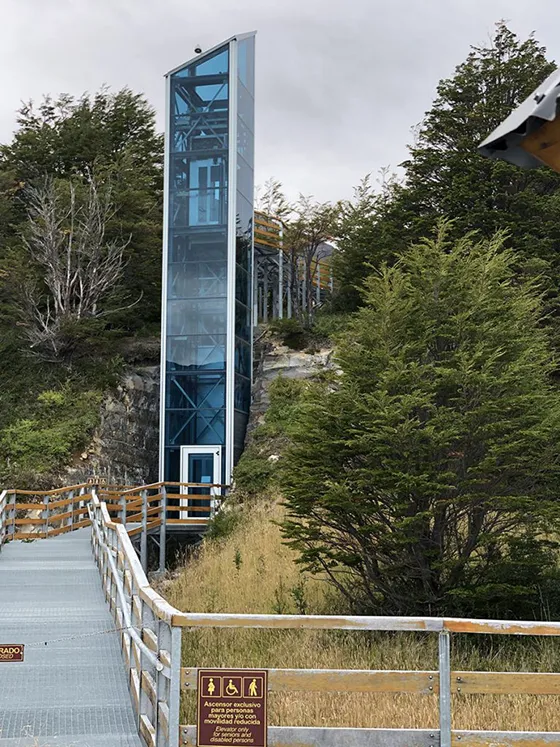
In recent years, since the establishment of the international airport, there has been significant economic development in El Calafate, the city closest to the glaciers. International tourism represents an important source of income for the growing tourism sector in the region.
Since the 1970s, tourists have been arriving to enjoy the Perito Moreno Glacier, undoubtedly one of the most outstanding natural wonders of Patagonia. As a result, the city of El Calafate has become one of the fastest-growing towns in Argentina. With a tourist accommodation capacity of around 7,500 beds, the city has solidified its status as an international destination, receiving more than 12 flights daily during peak season.
The Weather
The weather in the city of El Calafate is characterized by cold and dry conditions with a moderate annual temperature range. During summer, the average temperature in January is 13°C (55°F), with highs reaching up to 28°C (82°F). In winter, the average temperature in July is 1°C (34°F), with a record low of -14°C (7°F) recorded on July 27, 2014. Annual precipitation is approximately 150 mm (6 inches).
Mini Trekking on the Perito Moreno Glacier
In the surroundings of Lake Argentino, a wide variety of activities are organized, such as visits to tourist ranches, 4×4 expeditions to the Frías and Huyliche hills, horseback riding, excursions to the Laguna Nimez ecological reserve, and walks around Lake Roca. In front of Bahía Redonda, you will find the Andean Club, which was a pioneer in teaching mountain activities. It is open to the public and offers a climbing wall, a bar with views of Lake Argentino, and in winter, when the bay freezes, it provides skate and sled rentals.
In the area of the National Park, excursions to the glaciers are carried out, with the Perito Moreno Glacier being a highlight. Excursions include mini trekking on the glacier itself, navigation through the channels of Lake Argentino, and visits to the impressive Upsala, Spegazzini, Onelli, and Seco glaciers, among others.

Walking on the Glacier Ice
To walk on the glacier ice, you need special clothing and footwear, as well as the supervision of trained guides with extensive knowledge of the area. Tours offer a “mini-trekking” option, with a short one-and-a-half-hour walk and another option that usually lasts about five hours.
Glaciarium Museo del Hielo Patagónico
Located very close to the city center of El Calafate, 5 km to the west, is the Glaciarium Museo del Hielo Patagónico, a cultural and scientific center where the latest research on glaciers and their environment is shared. In 2011, the glacier interpretation center was inaugurated. In the basement of the Glaciarium Museo del Hielo Patagónico is El Glacio Bar, the only bar in the world built with glacier ice. Everything in this bar is made of ice, including the walls, furniture, glasses, bar, and armchairs. The bar has an area of 80 m² and an ambient temperature of –10°C (14°F).
More information for Access to the National Park
Only the Mitre-Glaciar Moreno Corridor has access hours: Summer: From September 1 to April 30 from 8 a.m. to 6 p.m. (with stay until 8 p.m.). Winter: From May 1 to August 31 from 9 a.m. to 4 p.m. (with stay until 6 p.m.). You can purchase a promotional pass with a 50% discount for your second visit to the Park through this APN sales site.

